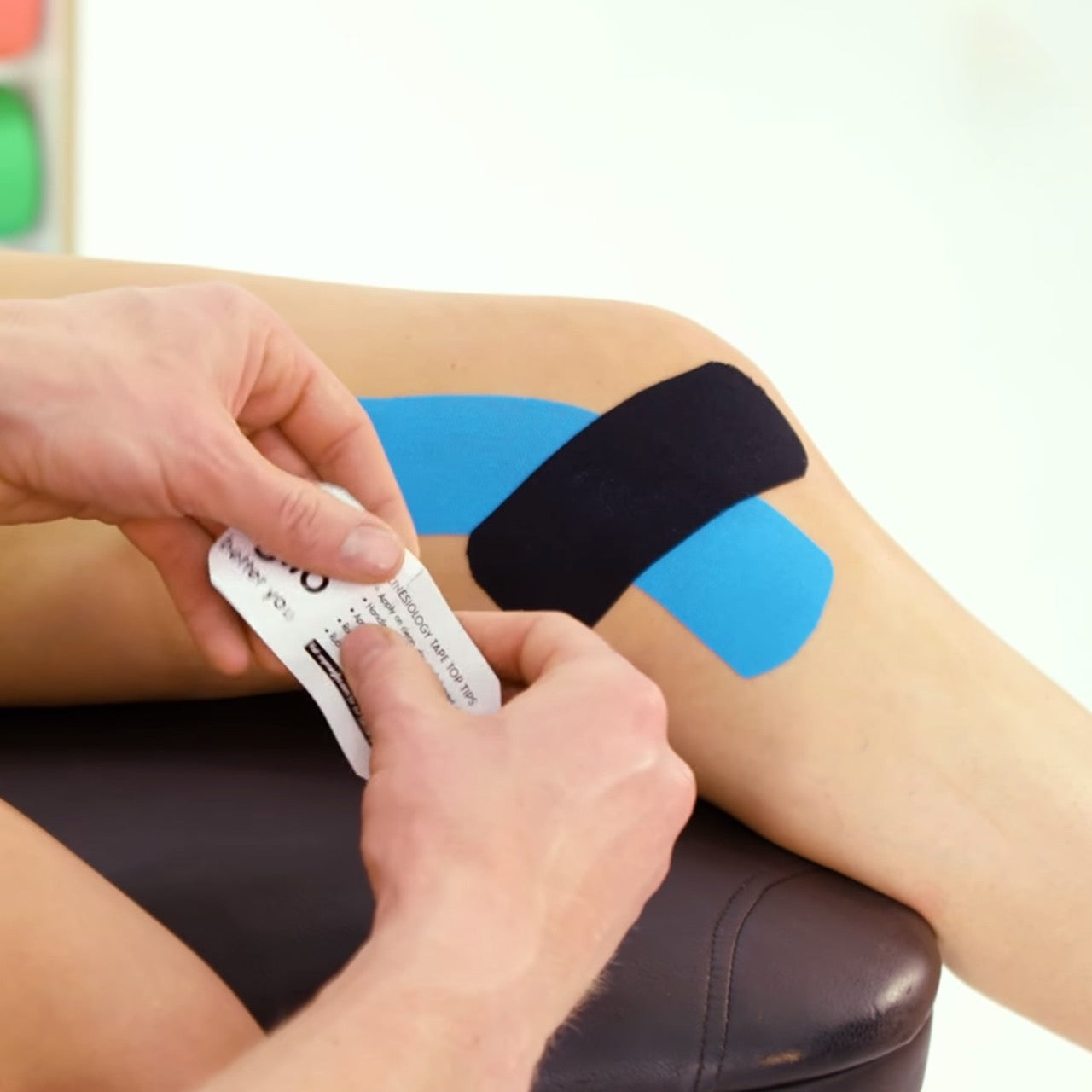Knee pain is common. It can affect anyone, from athletes to those living a more sedentary lifestyle. Knee pain from injury, overuse, or arthritis can seriously impact quality of life. Kinesiology tape is a popular method for managing knee pain. This stretchy tape is popular among physiotherapists and other movement experts because it can provide support, reduce pain, and enhance mobility.
Let’s explore the benefits of kinesiology taping and application methods for different knee injuries.
What is Kinesiology Tape?
Kinesiology tape, also known as k tape, is a therapeutic tape developed by Dr. Kenzo Kase in the 1970s. It is a stretchy tape, often made from cotton mixed with polyester and elastic fibres. Unlike traditional athletic tape, kinesiology tape allows full movement. It imitates the skin's elasticity while providing support.
Does Kinesiology Taping Work for Knee Pain?
Knee injuries can be caused by:
- Under- or overtraining
- Sudden trauma
- Knee mechanics issues
They are common in sports, especially those involving sudden stops, direction changes or direct impact on the knee. Knee taping can help improve knee stability and provide support during exercise.

NOTE: Always seek medical advice for proper diagnosis and treatment.
Some common knee injuries that could benefit from kinesiology taping are:
Osteoarthritis
Osteoarthritis is a common cause of knee pain. It degrades knee cartilage, causing the bones to rub together. It is the most prevalent form of arthritis, causing pain and stiffness and making everyday movement difficult.
A 2023 study in the Irish Journal of Medical Science found that kinesiology taping improved knee osteoarthritis when used in conjunction with physiotherapy compared to physiotherapy alone. After six weeks of physiotherapy and kinesiology taping, the 40 participants experienced improved pain, range of motion, and physical function.
A 2017 study found similar results with 42 participants. They used kinesiology taping or a placebo for a month. Researchers found that kinesiology tape had better short-term effects on walking, pain, and knee flexion range of motion.
Ligament Injuries
Overstretching and straining the knees beyond their normal capacity can cause ligament injuries. In sports, knee ligament injuries can result from a direct blow to the knee, twisting the knee and overuse. The anterior cruciate ligament (ACL), posterior cruciate ligament (PCL), and medial cruciate ligament (MCL) are the most frequently injured.
Kinesiology taping is often used to prevent or treat knee ligament injuries. It helps to stabilise the knee, reduce pain and improve movement.
One study found that kinesiology taping may help prevent ACL injuries from reoccurring. The researchers found that, after ACL reconstruction, kinesiology taping reduces the knee valgus angle. This lowers the risk of a secondary injury.
A similar 2016 study took 30 people who had ACL surgery. It assigned them to a kinesiology taping group or a sham control group. They found that alongside standard rehabilitation, kinesiology taping helps reduce pain and swelling while improving knee flexion range of motion and hamstring strength.
Patellofemoral Pain Syndrome (PFPS or runner's knee)
PFPS is a knee joint injury caused by overuse, misalignment, or imbalance in the muscles supporting the knee. The pain occurs in the front of the knee, around the kneecap or patella. It's common in sports that use lots of plyometric movements, like running and jumping, hence the nickname. Kinesiology taping can help manage runner’s knee by aligning the kneecap and supporting the patellar tendons.
Other common causes of knee pain include:
- Bursitis
- Chondromalacia patellae
- Iliotibial (IT) band syndrome
- Muscle tears
- Tendonitis
3 Common Kinesiology Taping Techniques for Knee Pain
NOTE: Always seek medical advice for proper diagnosis and treatment.
Taping for Runner’s Knee
- Prepare a Y-strip section of tape for the front of the knee.
- Tear a 2-3cm section of the backing paper away from the tape. This will be your anchor.
- Place this anchor halfway up the quad muscle without applying any stretch.
- Peel off the rest of the backing paper. Apply a gentle stretch as you place the tape on your skin toward the kneecap. Position the split sections around the kneecap.
- Place the final 2-3cm of each arm of the Y-strip together on the patellar tendon with no stretch. This will anchor the end of the tape.
WATCH: Our video guide for general knee taping.
Taping for Pain on the Inside of the Knee
- Prepare an I-strip section of tape.
- Tear a 2-3cm section of the backing paper away from the tape. This will be your anchor.
- Place your anchor just below the middle of the knee without applying any stretch.
- Apply 25% stretch to the tape and place it firmly against the skin.
- Leave a final 2-3cm of tape to stick down without stretch as your opposite anchor.
- Prepare two shorter pieces of tape.
- Apply them in an x pattern over the already applied tape. Use 2-3cm at either end as anchor points without stretch and apply 50% stretch in the middle portions.
WATCH: Our video guide for taping the inside of the knee.
Taping for Pain on the Outside of the Knee
- Prepare an I-strip section of tape.
- Tear a 2-3cm section of the backing paper away from the tape. This will be your anchor.
- Place your anchor on the outside of the knee just below the kneecap without applying any stretch.
- Apply 25% stretch to the tape and place it firmly against the skin to around halfway up the thigh.
- Leave a final 2-3cm of tape to stick down without stretch as your opposite anchor.
- Prepare two shorter pieces of tape.
- Apply them in an x pattern over the already applied tape on the outside of the knee where the pain is present. Use 2-3cm at either end as anchor points without stretch and apply 50% stretch in the middle portions.
WATCH: Our video guide for taping the outside of the knee.
Which Tape Should I Buy?
Several suppliers offer kinesiology tape in many colours, lengths and widths. It is also available as uncut or pre-cut strips or rolls.
A smaller roll is best if you use kinesiology tape for occasional personal use. A larger roll would be better if you need to tape more often or tape clients in a clinical setting.
About Meglio K-tape
Meglio kinesiology tape was crafted alongside physiotherapists and sports scientists. It is lightweight, flexible and water-resistant. Latex-free and made with natural cotton, it is suitable for most skin types. With proper application, Meglio kinesiology tape offers up to five days of flexible support.
Our kinesiology tape is 5cm in width and available as a 5m roll or a 31.5m roll length.
Ready to upgrade your knee care routine? Check out the full range of Meglio kinesiology tapes.







